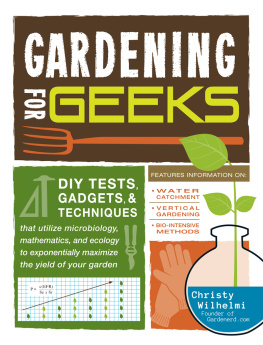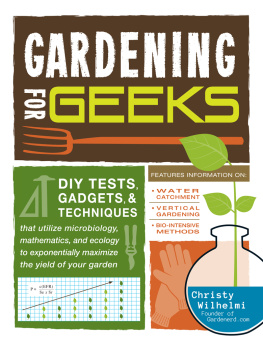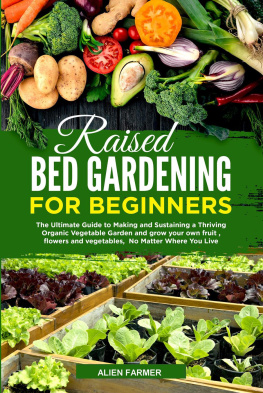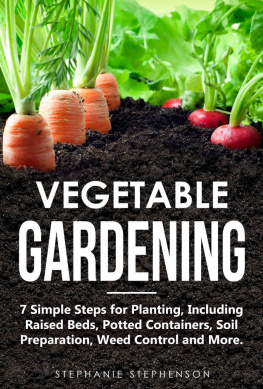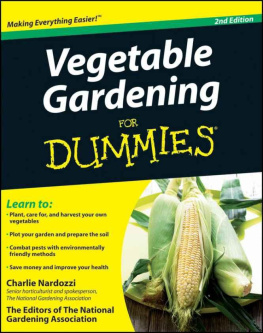DIY tests, gadgets, & techniques that utilize microbiology, mathematics, and ecology to exponentially maximize the yield of your garden
Acknowledgments
There are so many geeks to thank, and numerous shoulders I leaned on throughout the process of writing this book. First and foremost, my patient and marvelous husband Andrew Cheeseman, who put up with months of neglect and take-out food while I threw myself headlong into this project. His well-trained grammar-geek eyes and physicist/math brain helped hone these pages. To Hexie Cheeseman and Suzy Wright, for being two more sets of eyes proofing my work, thanks so much for your invaluable help. To the ladies of my writers group, all unwavering cheerleaders, your encouragement and knowledge of the writing world made this much easier. To Jonathan Blank, who knows a thing or two about book publishing and willingly spent time sharing it with me, I cannot thank you enough.
I must draw particular attention to the garden geeks who have inspired my gardening exploits throughout the years (in no particular order): John Jeavons, Mel Bartholomew, the late Geoff Hamilton, Rosalind Creasy, Michael Pollen, David King, Jere Gettle, Louise Riotte, Barbara Kingsolver, and everyone at Ocean View Farms organic community garden. To those who helped clarify the material for this book, I appreciate the access you afforded me: Victoria Boudman of the Square Foot Gardening Foundation, Eben Fodor of SunWorks, master preserver Rose Lawrence of Red Bread Bakery, irrigation wunderkind Russell Ackerman, and again, John Jeavons of Ecology Action.
Special thanks to Martha Brown at UC Santa Cruz and David Rosenstein of EVO Farm for taking the time to show me around their fabulously geeky gardens. Last but never least I must thank my parents, Frank and Jo Wilhelmi, for being the engineer/carpenter and nurse/wonder-cook geeks who begat this geek.
INTRODUCTION
Whats It All About?
When garden geeks get excited about a subject, they want to know everything. Gardening is an exciting topica vast world of soil biology, botany, and horticulture. It cross-pollinates with the insect world, meteorology, and nutrition. The more we learn about gardening, the more we realize there is to learn. Its a wonderfully addictive passion to have.
Do you want to know everything? This is a great place to start, but keep in mind that gardening knowledge doesnt arrive in a specific sequence. With the exception of the seasonal calendar or a planting schedule, gardening is not linear. It shifts each year, challenging us to figure out natures next step. It tests our instincts as much as our knowledge, and in the end nature always wins. Most of the time we benefit from natures triumph, but just like Olympic athletes, garden geeks experience both the thrill of victory and the agony of defeat.
This book is meant to be a geeky gateway into all things cool about gardening. It gives you the basics to start designing and building the garden of your dreams. It also will lead you to bigger concepts to explore later, when youre ready. It delves into the science of how plants work, how soil lives, and how bugs help. Even though it takes you step by step through the process, I encourage you to jump around through the book. Early on, youll notice references to later chapters. If you cant wait, feel free to jump forward and read. Whatever floats your boat!
The information in this book is compiled from several classes I teach, with extra-added nerdy details that dont fit into the confines of the classroom. Students have been asking me to put it all down in one place. Well, here it is. Have at it. I hope you enjoy this journey into the geeky side of gardening. Put on your gloves and lets get started.
Happy gardening!
Chapter 1

CREATING YOUR GARDEN ECOSYSTEM
There are many things to consider when planning a garden. Location is everything, but not the only thing. Sure, its important to make sure your garden will get enough sun (a minimum of six hours per day), but lets talk about the other factors. Lets talk about your garden ecosystem. After all, your garden is a community of living things, and for it to flourish, theyll all have to get along together.
Wherever your garden is located, be it on a balcony, patio, or backyard, you will want to create an environment that supports your efforts. Your gardens ecosystem can provide shelter, windbreaks, and even pest control assistance if you include a few key elements. From simple to more complex, the following components all play a role in that ecosystem.
Habitats
Established trees are an important part of your gardens ecosystem. Not only do they absorb carbon dioxide and release oxygen for a healthier planet, but they also provide a place for birds and insects to live. Ants and other insects crawl through the trees bark, and birds take advantage of that traffic. Birds build nests and lay their young, or visit on their way to higher latitudes. Then they scavenge your garden for food, and in the process they provide pest management services for you, gobbling up bugs and worms.
You can help provide a reason for birds to congregate in your garden by hanging bird feeders and seed cakes. Birdhouses, made from gourds or wood, provide a habitat as well. Many gardeners grow sunflowers, which develop dinner-plate-sized seed heads, to attract birds. While its true that these winged creatures will enjoy your sunflowers whether you want them to or not, the benefits of having birds in the garden generally outweigh the negative effects.
Bats
Bats, if you have them in your neck of the woods, help reduce the pest population by swooping through the sky at dusk like airborne vacuum cleaners, eating bugs in mid-flight. According to Bat Conservation International, bats consume night-flying insects, including many of the most damaging agricultural pests A single little brown bat can eat up to 1,000 mosquito-sized insects in a single hour. Bats serve other purposes as well. Did you know they are pollinators? As they drink nectar from flowers, they help pollinate many cacti and fruiting plants. As a bonus, they leave behind droppings called guano, which happens to be among the best fertilizers around. Bat droppings include 1116 percent nitrogen, 812 percent phosphoric acid, and 23 percent potashall components of healthy soil. Guano can also serve as a composting starter and a fungicide.
If you are reluctant to welcome bats into your world, this is a good time to let go of creepy bat stereotypes. With bat populations in serious decline, they need all the help they can get. You can install a bat house on a wall under the eaves of a home, garage, or shed to encourage bats to take up residence. Bat houses are narrow boxes with even narrower compartments inside (about 34" deep) that allow bats a place of safe, dark shelter. In a study published in The Bat House Researcher in spring, 2004, it was revealed bats prefer larger bat houses (at least 20" wide 25" high) that are painted and mounted on a building, rather than mounted on a post or trees. You can find several free plans for building your own bat house, along with tips for attracting bats, on the Bat Conservation International website, www.Batcon.org.
Toads
Toads are another great addition, and pest consumer, for your garden. They consume slugs (yay!) and worms (like nasty cutworms that mow down your kale plants before the seedlings ever reach harvesting size). Granted, toads dont inhabit every climate zone, but where there is moisture and shelter, they often make a home. Make a toad house out of a terra-cotta pot by chipping off a wedge of the upper rim of the pot. Turn the pot over, nestle it into a grassy corner, and

